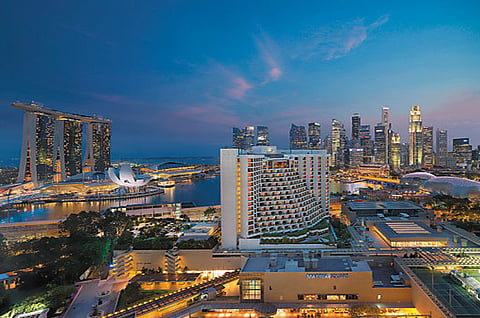
- Locations
- Interviews
- Luxury Home
- Luxury Lifestyle
- Luxury Travel
- Events
- More
- Magazine
- Contact
- Media Kit

By:Rory Winston

The renowned Singaporean poet Alvin Pang once described the half-fish half-lion national mascot, Merlion in the following way: "Even though there are more websites on you than verses, even though you evoke cameras more than pride, postcards more than praise, still you seem to have a face poets love to woo". The same could easily have been written about the city's paragon of a luxury hotel, the Mandarin Oriental. Designed by John Portman, this local variation of the lady's fan is a virtual theatre where Singapore itself takes center stage. With enormous windows opening onto Marina Bay, the Pacific Ocean and the breathtaking city skyline, the establishment evokes a sense of timelessness – one that straddles the organic splendor of the island while simultaneously paying homage to both contemporary and historic European and Asian influences.

Besides being situated alongside the much lauded Orchard Road (which boasts some of the best shops in all of Asia, let alone the city) the Mandarin Oriental celebrates culturally diverse influences by hosting a full range of culinary traditions. As the establishment's executive sous Chef Eric Cheam is aware, Singapore is a juxtaposition of Chinese, Malay, Indian, Peranakan and European themes. While Mandarin's Cherry Garden plays off an eclectically Cantonese menu wherein the Feng Shui inspired trappings collude with contemporary culinary whimsy to create a nuanced balance between authenticity and reinvention, Melt World Café addresses island traditions by employing a colorful 'show kitchen' that highlights the intricacies involved in chefs reworking selections as varied as Thai to Tandori to Hainanese.
In truth, there's probably no better way of ending an excursion to Singapore's Chinatown Heritage Centre – with its faithful renditions of nineteen century bedrooms, kitchens and street scenes – than by returning to the Mandarin Oriental to indulge in some chicken and rice from Hainan province, some delicious Cantonese dim sum, or some spicy Szechuan dishes. But whether one's day follows the usual American plotline – which includes anything from turning up at the Camden Medical Centre for a quick nip and tuck to taking in a panoramic view of the city from atop the 165-meter high Ferris wheel known as the Flyer – the perfect denouement for any story is recounting the day over some of the fine Malay foods on offer at the hotel.

Nasi Lemak, Rending curry, satay or a light gado-gado all make a convincing case for how multiculturalism enhances rather than impedes time honored traditions. The Perankan Chinese who immigrated to Malaysia in the 15th to 17th century infused their stews with motifs that ran the gamut from Chinese to Indonesian. It is this legacy of fusions that still pervades the local approach to cuisine. In addition to the more expected Asiatic concoctions on offer, Mandarin oriental celebrates the Hindi and Indian Muslim specialties with grilled tandoori meats and seafoods, as well as nasi biryani and spicy mutton curry.
For a more Japanese oriented day, take a quick trip to either Know It Nothing – where fashionistas pick through Garni labeled attire – or go to Funan Digital Mall for the latest in electronic gadgets. Regardless which venue one chooses, Mandarin Oriental can give you perfect closure with its Wasabi Bistro – a Californian edged Japanese restaurant that makes a perfect companion piece to your Nippon adventure.

Of course, Singapore is more than just a slice of Asia. It is also a city-state that has inherited certain features from its colonial days as part of the British Empire. Local nightlife is a testament to this fact. Bustling clubs like Zouk or Ministry of Sound are inherently European and American in nature. Similarly, Mandarin Oriental's contemporary Italian kitchen Dolce Vita and its all-American dinner, Morton's Steakhouse, are as much a part of the elite Singaporean experience as their exotic Asian counterparts.
Sloping towards the stars like an ancient temple, the bone white Oriental property cradles a 25-metre outdoor pool as though it were a contemporary mote – there to keep the world at bay. With expansive beds –complete with custom linen and down – each of the 468 rooms and 59 suites has a separate bath and walk-in shower. The large working desk, LCD TV's, quality sound systems and high bandwidth, all attest to the notion that state-of –the-art technology does indeed thrive within a Zen-like atmosphere. The design elicits Singepåorean sensibility – ultimate practicality with unlimited comfort.
With private yoga lessons, foot spa and state-of-the-art fitness centre, one gets the sense of just how well a Sri Vijayan emperor would have lived centuries ago. It does not take a wild leap of the imagination to understand why so many nations have fought so hard to keep this region of the world.

Sitting in my room at the Mandarin Oriental, I looked out beyond the palm trees and took in the star-studded sea where a half-moon dangled over the waters in what appeared to be no more than a vain attempt to catch a glimpse of its own reflection. With a similar level of self-indulgence, I admired my silhouette in the room's window while announcing to no one in particular: yes, I am actually here.
